Technology
Services
Resources
A customer or consumer data platform (CDP) is a platform or a software that creates a persistent, unified record of customer data that is accessible to other systems. Data is integrated, contextually enriched from multiple channels or sources, to create a single consumer data profile. This integrated and structured data can then be utilized by other marketing systems for various use cases like bid optimization, personalization, segmentation for ads and emails etc.
According to Gartner, “Customer data platforms have evolved from a variety of mature markets, including multichannel campaign management, tag management and data integration.”
So, then, why is customer data integration vital for insights-driven businesses?
Gone are the days of spray and pray marketing to promote businesses. Big data was a buzzword more than five years ago, but it continues to be relevant for business success today. Offerings from customer data insights have evolved into multichannel campaign management, tag management, identity resolution etc.
Consumer digital footprints are now larger than ever, giving enterprise businesses significant opportunities to target, market to, and maximize the lifetime value of customers. Businesses that take full advantage of big data and consumer data insights to meet these goals are uniquely positioned to stay ahead of the competition and thrive in the long run.
A recent Forrester report calls companies that focus on the value of data “insights-driven businesses”, and they’re set up to dominate the competitive market. Those that prioritize data insights are growing at an average of more than 30% annually and will earn a projected $1.8 trillion by 2021.
A lot of what empowers insights-driven businesses is technologies that allow them to process and analyze large volumes of relevant data at scale. But that’s only one piece of the puzzle. Successful organizations also develop a business culture where these insights are maximized and constantly used to inform decisions and improve processes.
Most enterprise businesses today know the value of big data and consumer insights, but few are prepared to make all the necessary changes to fully benefit from it. According to a recent global research report by Cloudera, 69% of enterprise organizations view having a comprehensive data strategy as a requirement for meeting business objectives, yet only 35% think their current analytics and data management strategies are sufficient for this purpose.
Choosing the right management platform for your business needs is valuable, but there’s a lot more to building an effective enterprise data strategy today.
Investing in technologies that can integrate, manage, and analyze the wealth of relevant business data out there is the first step towards success. In order for enterprise businesses to maximize the value of major data analysis initiatives, they must also create an internal strategy for success.
This includes a clear vision for what the business hopes to gain from data analysis and a roadmap for achieving this. Key players at different levels of the business, beyond marketing or data science teams, must have a vested interest in this strategy.
Illustrating clear goals for your data analysis initiatives impacts your approach significantly. Here are some of the many ways it can inform your strategy:
Some of the goals you define may depend on your type of organization and industry. That said, most businesses want to use data insights to inform strategies that can help them reach new customers, earn their loyalty, attract investment, beat their competitors, and improve other business capabilities.
Once you have a clear understanding of what you hope to achieve with data analytics, you’re ready to identify which strategies and data management solutions you need to succeed. The types of data you need will depend on the different analytics goals you set out. Some examples include:
This is the area where choosing the right data platform is most important for insights-driven businesses. There are plenty of data management solutions out there that can automatically collect, process, and analyze some of the important data points businesses need to meet their analysis goals. But missing even one or two of the key data streams means missing out on important insights or wasting time and resources with manual analysis.
Insights-driven businesses should focus on finding a data management platform that offers the most integrations to process and analyze all relevant data for their business goals. Either that or be prepared to invest in a partial solution and manage the rest manually with internal data science teams.
Once you know what systems and technologies you’ll use to manage your data, it’s also essential to define clear data management roles. Not everyone is a data scientist, and many people outside of the analytics team will likely come into contact with and/or edit your enterprise business data. In order to maintain data integrity and management efficiency, it’s important to define key roles so everyone understands expectations related to data management within the business.
Identify all individuals who may perform some tasks in your data science pipeline. You may discover that internal team members don’t have enough skills or the capacity to meet analysis needs. In this case, it can be worthwhile to enlist the help of third-party agencies to work with your data and analysis tools. This is a common strategy among enterprise-level businesses - in fact, spending on marketing agencies accounts for nearly a quarter of marketing budgets today, according to the latest Gartner research.
Once you know exactly who will be interacting with your business data, you next need to detail what kind of tasks they will perform with it. When enterprise businesses actually take the time to do this, it’s easy to find ways to improve data analysis efficiency and performance. Your data scientists, for example, are an incredibly valuable asset for deriving insights, despite what automated technologies have to offer. Often, they spend significantly more time (as much as 80%) preparing data than actually performing analysis. Why not delegate some of the more tedious tasks to data managers, allowing data scientists to focus on the work that matters most?
In enterprise-level businesses, there are often issues with teams working apart from each other. This is true both within data management and IT tasks, as well as with the rest of the business. Insights-driven businesses need to make specific changes to their organizational structure to sidestep this issue. For starters, avoid allowing your data scientists to work in silos. It makes sense to assign different teams to work on different goals, but they should still have an integrated approach.
Ensuring clear communication between IT and business leaders is critical for success. Creating and approving clear data management goals is just the first step of this collaboration. There needs to be ongoing feedback between different units to ensure data insights remain the most valuable to current business needs.
Many business leaders believe that data should only be accessible by the teams that analyze it. But making it more widely available to invested teams throughout the business can maximize its value for reaching business goals in the long run. Breaking down silos may cause some confusion in the short term, but the long term benefits are worth the effort.
Once a business is certain that technologies and teams are set up to maximize the value of big data, they need to ensure they’re prepared to report on data insights. How you approach this is largely based on previously outlined goals. Several important areas include:
Create reports that help improve operational efficiency and effectiveness. Relevant data insights should be made available to key players across the organization. Encouraging this kind of data-driven company culture makes it possible for all department leaders to improve internal operations based on these insights.
In today’s highly competitive digital landscape, efficiency is the factor that can set an enterprise business apart from its competition. Data insights can help a business identify problems and take action to streamline internal processes. Success isn’t just about improving marketing performance. Data insights can be applied to sales, customer relations, product distribution, employee performance, and more.
Marketing investment insights are probably the biggest opportunity to drive more revenue from data insights. Campaign performance data can tell a business a lot about what strategies work and which don’t. Bidding technologies are uniquely positioned to help businesses automate changes based on these insights.
The time and energy marketing managers save by using automation needs to be reinvested into other initiatives. Evaluating the ROI of different marketing channels, exploring new options, experimenting with targeting strategies can lead to new data insights that improve performance even further. Insights-driven enterprise businesses need to be prepared to use both automation and manual data insights to inform future marketing investment decisions.
Advanced data analysis can require significant time and financial investment, between collecting, processing, storing, analyzing, and taking action based on insights. Enterprise executive officers today understand that data insights are necessary for success. But they also need a clear picture of the benefits if they’re going to continue investment in the long term.
That’s why from the very beginning, there needs to be analysis processes in place to illustrate how this investment relates to the business’ bottom line. Linking data insights to drive specific marketing goals is one thing. But what’s the direct impact on sales? How does investment balance out in terms of ROI?
Another critical aspect of running an “insights-driven” enterprise is that the insights truly drive action. There needs to be a company culture in place that ensures data insights are utilized continuously throughout the organization to improve processes and meet internal goals.
What makes this happen are teams ready to act quickly on insights to create a competitive advantage. But in 2020 and beyond, success is also largely based on automation technology. Look at the search advertising landscape, for example. Opportunities to optimally target search audiences exist in what Google calls “micro-moments.” Consumers leave a digital footprint suggesting their intention to buy. But often they’re searching for businesses while they’re on the road, or standing in line at a store about to buy. The time between expressing purchase intent and actually buying is a micro-moment. But it’s something advertisers can target when they use automation technology.
Bidding automation technology, for example, can make micro-changes to a bid strategy throughout the day in real-time based on the latest data insights. Instead of waiting on data teams and data scientists to make targeted changes, automation technology can ensure all relevant data is used in a timely manner to optimize campaigns.
There are lots of ways automation technology can help insights-driven businesses succeed today. Using the right data management tools in combination with internal business processes is essential to maximize the value of this strategy.
Today, there’s a wealth of relevant consumer data that businesses can use to optimize their marketing and sales strategies. The volume of relevant data is so great that customer data management technology is an essential requirement for success. But that’s far from the only thing enterprise-level businesses need to build an effective and efficient data strategy.
Insights-driven businesses choose the right technologies for their goals as well as develop internal processes to maximize their value. This includes creating an organizational culture that regularly utilizes data insights to drive change.
How to build an effective marketing attribution strategy to avoid dependence on Google, Facebook, or Amazon
Building an accurate attribution model is more important for digital marketers today than ever before. According to the latest Forrester research, end-to-end B2B conversion rates are 0.75% on average. A lot happens between the first and last interactions with your business that can influence conversions. That’s why it’s essential to build a comprehensive attribution model using the highest quality data that illustrates your customer journey.
Truly understanding which marketing initiatives are responsible for sales and revenue can help you make targeted changes to improve performance and drive a greater return on investment.
Today, there are a number of major platforms that address marketers’ attribution needs in terms of quality, testing, and data management. But do the benefits of working with one-stop-shop platforms outweigh the problems they create in data management?
Here’s an overview of the most popular options:
Google has always been the forerunner in providing attribution technology. Google Analytics is a free tool anyone can use to track different touchpoints in the customer journey and attribute them to sales. Google Ads also has attribution capabilities for paid advertising.
Attribution 360 was originally an enterprise-level offering, but now a simplified version is available for everyone. It integrates with Google Analytics, Google Ads, and DoubleClick Search. This allows advertisers to analyze cross-channel performance data, as well as upload offline conversion data. You can assign whatever attribution model you want to your conversion events, as well as compare different models.
Facebook Attribution is the newest major option out there, designed to help you build a clearer picture of the customer journey. You can use it to assign credit to various audience touchpoints across your Facebook, paid, or organic efforts and then estimate the incremental impact of your marketing on Facebook, Instagram, Audience Network, and Messenger.
Using Facebook Pixel on your website further makes it simple to target previous site visitors with ads on the social media platform. You can then use data-driven attribution modeling to see how your efforts pay off.
Last year, Amazon introduced its own measurement solution for brands that sell on the platform. It allows them to measure the impact of display, search, social, and video channels based on consumer behavior on Amazon. It includes valuable conversion metrics like page views, purchase rates, and sales. Ultimately, you’re able to get a comprehensive understanding of how your marketing tactics across the web impact shopping decisions on Amazon.
On the surface, it looks like there are a number of easy solutions for marketing attribution today. Marketers just have to decide which major platform is the most valuable for their audience data needs. However, simply relying on big players like Google, Facebook, and Amazon creates some inherent issues that businesses should be aware of.
These platforms provide valuable data on consumer behavior at a granular level that you just can’t get elsewhere. But once you start relying on them to track your own audience behavior, you lose control over your data entirely. These platforms operate using what is called “walled garden” data management. They have complete control over audience data, making it impossible for businesses to utilize it for their own analyses.
Walled garden scenarios with Facebook and Google have been in the news for a while:
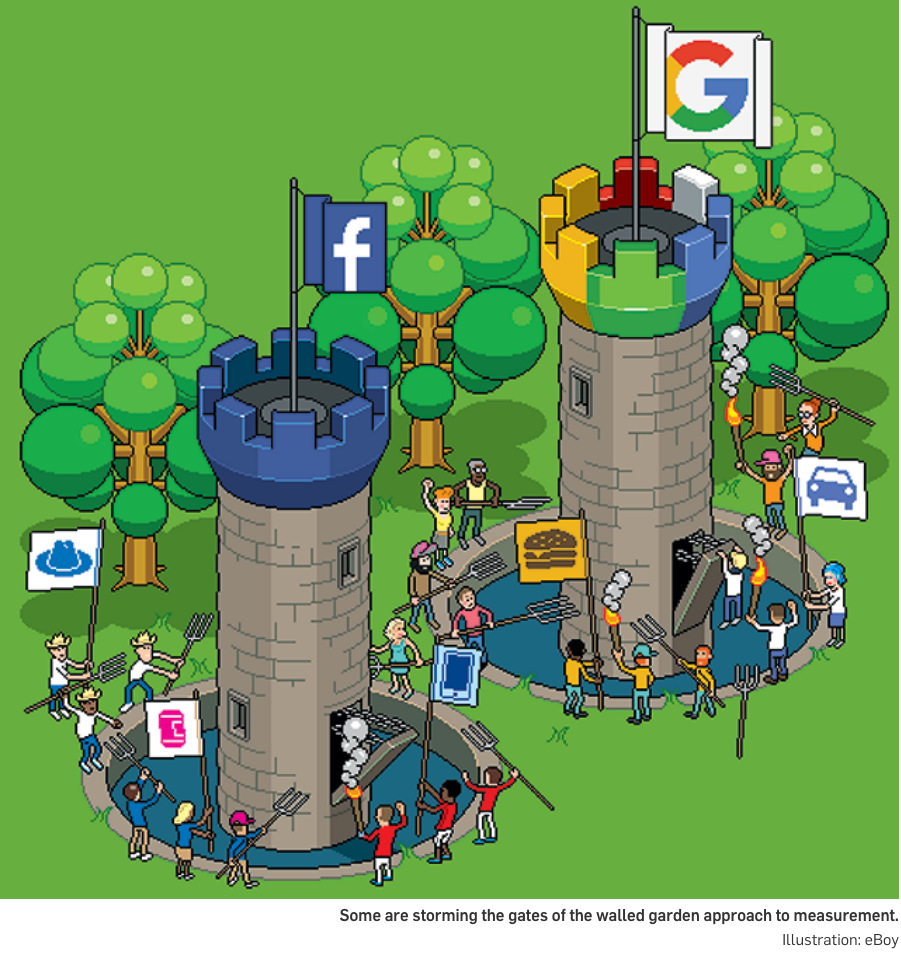
Now Amazon recently joined their ranks.
Working with walled gardens for marketing attribution can provide a lot of value, but it also encourages businesses to relinquish control of their own audience data. Features like Google’s tracking tags and Facebook’s tracking pixel give them control of your first-party data as well as the third-party data they provide. This might seem like a worthwhile solution given data management regulations like GDPR and the California Consumer Privacy Act, but managing your own consumer data is infinitely more valuable because you can perform your own unique analyses. Platforms like Google, Facebook, and Amazon are also under no obligation to give you full access to your audience data if they don’t want to.
With all that in mind, choosing an attribution technology should be about more than just selecting the best walled garden to work with. Forward-thinking marketers are prepared to use third-party tools that give them the freedom and flexibility they need to manage their own data while building a powerful attribution strategy across a clear customer journey.
Attribution modeling is an evolving art. As the volume and depth of audience behavioral data continue to grow, businesses are learning there are many different ways to attribute value to your marketing efforts. Choosing the most accurate attribution model is important, as it can drive decisions to optimize marketing campaigns and gain more sales.
Here’s an overview of the main options for attribution modeling in 2020:
This is the standard model used traditionally in Adwords and with many other platforms. All credit is assigned to the last touchpoint before converting. This model doesn’t consider any other interactions a customer made with your business before converting.

First click attribution gives 100% of the credit for a conversion to the first interaction with your business. If, for example, someone finds your business from a PPC ad, clicks through and converts, the ad would receive all the credit for the conversion.

This model also assigns 100% of the conversion value to a single interaction. If someone types in your URL then converts on your website, this model ignores that last click and instead focuses on the interaction that came right before it. It’s a valuable option for businesses that get a lot of direct traffic to their website.

Linear attribution splits credit for a conversion across all the interactions a customer has with your business before converting. Say they find your business on Facebook, sign up for your email list, then go directly to your site URL to convert. Linear attribution would give equal value to each of these 3 interactions.

Time decay works like linear attribution in that it assigns value to several different touchpoints across the customer journey. The only difference is that it assigns more value to the touchpoints closer to the point of sale. So it might assign 15% value to the first two touchpoints, 30% value to the third touch point and 40% value to the last. It’s possible to adjust how much value you assign to each touchpoint.

The U-shaped (or position based) attribution model prioritizes both the first and last interactions before a sale. It’s based on the idea that the first time someone discovers your business and the last contact point before they convert are the most valuable for driving conversions. In this case, 40% of the credit is given to the first and last touchpoint while 20% is split between the other interactions in the middle. This results in a U-shaped graph for attribution.

A custom attribution model involves assigning whatever value you want to the various touchpoints in a sales funnel. No one understands the inherent value of different pieces of marketing material more than those who created them. If you have touchpoints in the middle of the funnel that you think are more valuable for driving conversions, you can assign a custom percentage of value to it.

Algorithmic attribution is a more advanced modeling strategy that relies on machine learning technology to assign a value to your various touchpoints. It uses historical performance data, including won and lost deals, to create a unique model with custom weights for your customer journey. Also known as data-driven attribution, this strategy is able to make more nuanced inferences and changes to your attribution model based on your unique audience. To use this attribution model, you need advanced technology designed specifically for this purpose.
~
So, which attribution model is right for your business? The only way to know is by testing out different models and comparing their performance. It’s important to utilize technologies that offer the flexibility to test and compare varying modeling strategies.
That said, the data you feed an attribution model is just as important as the model itself. Marketers need access to nuanced, high-quality data regarding audience behavior and the customer journey across marketing channels in order to get a full picture of their marketing operations.
Luckily, there are a number of technologies out there that can help marketers create their own beautiful landscapes instead of relying on the walled gardens. QuanticMind, for example, helps you integrate and manage your data and help you employ data-driven attribution models. Some options are integrated marketing solutions, some are for attribution only, while others focus on tracking specific marketing channels. Assuming you plan to avoid relying on walled garden data giants, some third-party options include:
The list continues to grow. If you want to invest in technology that rivals the capabilities of Google or Facebook attribution, here are a few key features to look out for:
Unquestionably the most important element you need to build an accurate attribution strategy is data. Your marketing attribution technology should be able to manage your first-party audience data while simultaneously integrating with third-party providers. Tracking all customer interactions across numerous platforms is important for building a clear picture of the customer journey. This includes on-site, search, social media, email, and even offline conversions.
If you use certain technologies for data management as well as analysis, then they should have processes in place to accommodate privacy regulations such as GDPR.
Competitive intelligence is the ability to monitor your marketing performance compared to other major industry players. This can include news monitoring, tracking trends in news mentions, and analyzing how your PR initiatives perform compared to others. This can be based on keywords for search advertising, news topics, social signals, or other important factors. Advanced technologies can also provide recommendations to improve your marketing strategy based on historical performance and the current industry landscape.
The best technologies offer flexibility in the types of attribution models you can use to analyze marketing performance. Customization allows you to build any kind of attribution model that makes the most sense for your business. You can also analyze your data using a variety of different models (last click, linear, U-shaped, etc.) and compare results.
Data-driven attribution is widely considered the most nuanced option with the most potential to deliver accurate results. Investing in an attribution technology with machine learning capabilities will allow you to test the performance of data-driven attribution versus other models.
Effective attribution isn’t just about building the best model. It also involves having the analytical capabilities to truly understand the impact of individual touchpoints on your marketing goals. Important tracking features include:
Most importantly, your technology should be able to make connections between specific marketing initiatives, use cases, and their value for ROI. You need to be able to build a clear picture of how financial investment and marketing initiatives impact sales and revenue. Comprehensive data about the customer journey and historical performance allow the tool to accurately attribute cost and revenue data to specific bidding decisions.
Building a comprehensive, accurate attribution model is essential for advertisers to understand the impact and value of their marketing initiatives. But these insights are only valuable if marketers are prepared to make quick, targeted changes to their strategy based on performance. The competitive landscape is constantly changing. Touchpoints in your sales funnel that were once responsible for significant revenue can quickly become less valuable over time. Marketers need to stay on top of these changes if they want to maximize the value of comprehensive attribution long term.
That’s why predictive advertising is the perfect solution for search engine marketers today.
And this is where QuanticMind comes into play. Our automated bidding technology collects all important data points to assign value to clicks and identify the most profitable price to target your PPC ads.
It also offers more precision than any stand-alone attribution technology by using decimal conversion values, allowing it to attribute a conversion to multiple clicks. This illustrates how specific keywords, audience targeting, and bids impact the path to purchase.
Based on these nuanced attribution insights, QuanticMind uses automation to make new bid decisions. This ensures your paid search initiatives are always optimized.
Businesses today have a lot of options when choosing marketing attribution technology. In summary, the keys to success are:
Lastly, consider investing in technology that can help you build a nuanced attribution model as well as automate campaign optimizations based on these insights.
As competition in the paid search space intensifies, the use of automation to manage digital programs follows suit. The push and pull between full automation, partial automation, and manual bidding only further muddies the water. So what is the best approach?
There is no right or wrong answer when choosing a bidding strategy—the answers are not always black and white. To add more confusion, Google has begun adding error messages in Google Ads Editor to not-so-subtly push advertisers into using their automated bidding platform.
For advertisers that don’t work out of editor that often, below are examples of the error icon and error messages coaxing the implementation of Smart Bidding:


Another new tactic Google Ads has rolled out in beta is the Optimization Score. "What does that mean?" I hear you ask. Good question.
Here is their definition: “Your optimization score is an estimate of how well your account is set to perform. Apply the recommendations to help your campaigns perform better and raise your score.”
In short, the Optimization Score is a really smart way to talk advertisers into spending more money. If you’re competitive like me, you’re going to do what you can to get the highest score possible, which seems like it’d be a good thing, right?
In reality, a lot of the recommendations Google offers to improve your optimization score revolve around their best interests. Examples of negligent recommendations include raising audience bid modifiers by over 200% and raising daily budgets by over $400. Budget-related recommendations are often embellished in order to encourage advertisers to spend more money in Google Ads. They aren’t necessarily beneficial to advertisers, nor are some of them even realistic with budget constraints.
It’s not all bad, though. Google Ads optimization score does offer some useful tips to improve campaign performance. Some useful optimization suggestions include using new ad types, utilizing extensions, and editing ad groups missing ads or keywords, to name a few. To find your account optimization score, navigate to the left menu > click on recommendations, and the header of the recommendations tab will show your account’s optimization score and how to improve it. Screenshots below will outline what to look for:

Below is an example of a recommendation to switch to smart bidding, and what difference it would make to your optimization score.

To make viewing suggestions simpler, you can click the three dots on the right and click “dismiss all” to clear these recommendations:

Here are the steps to remove these errors in Google Ads Editor: Click the error to expand and view the message (which should look like the screenshot below)
1. Click “Show Rule” which will navigate you to the right side of the editor page and show custom rules set to flag campaigns using manual bidding.
2. Click the X next to any of the rules that include manual bidding - enhanced CPC or manual bidding
3. Hit save on those filters and that should remove these error messages in your Editor view.
4. Another simple way to remove these error alerts is to hit “ignore” on each message but this is a more time-consuming option.

Digital advertisers should always keep an open mind when viewing Google’s recommendations. The opportunity to try new strategies with ads, keywords, and extensions can be tempting if your performance is not at the desired levels, but some suggestions are not advisable to act upon, particularly when they relate to bid strategy and budgets.
Amazon’s invasion of the SEM territory has officially begun. Last year, Amazon’s search ad revenue surpassed that of Microsoft, taking the number two spot behind Google. Amazon will end this year strongly with a 12.9% search ad market share, while Microsoft will take a mere 6.5% of that same pie. According to eMarketer, this dark horse is expected to take additional market share from the top players and secure $11.7 billion of search ad revenue between now and the end of 2021.
Amazon has a compelling advantage over its eCommerce search engine counterparts thanks to its unique position at the bottom of the consumer buying funnel. Today’s consumers visit Amazon to discover new products, read reviews on and/or price check a product. But Amazon truly stands out because those who search on this site are already in the mindset to make a purchase. Unlike its competitors, Amazon does not need to persuade potential buyers down the conversion funnel.
Given the inevitably immense advertising influence of Amazon sponsored ads, and with the winter holiday season fast approaching, let’s explore some best practices around preparing for peak shopping periods on Amazon. You’ll be able to apply these methods for various shopping dates such as Prime Day, back-to-school season, Valentine’s Day, Mother’s Day, and many more.
Your first step is to understand your business goals for the upcoming peak shopping season. If you’re unsure, start by answering this question: Is my main objective to drive brand awareness or sales? Note that it’s entirely normal to have more than one goal. However, you should be able to prioritize given multiple goals.
Next, align your targets with your goals. If you’re looking to boost brand awareness, your success metric would be impressions. Therefore, make your brand and products visible to more shoppers by taking measures to increase traffic. If eligible, run both Sponsored Brands and Sponsored Products campaigns in order to maximize your opportunity to reach as many potential customers in multiple ad placements (i.e. search results top of the page and product details page). Sponsored Brands campaigns are highly effective in reaching potential customers, still lingering at the top of the conversion funnel, with new brands and product offerings. However, if your campaigns are receiving less than expected impressions, make sure:
On the other hand, if you’re determined to drive more sales, then your key success metrics would be conversions and Advertising Cost of Sales (ACoS). Once you have a significant amount (i.e. at least two weeks) of historical data, conduct a keyword-level performance analysis to identify the top-performing keywords that will help you reach your sales goals. Additional metrics you might find helpful in determining which keywords to raise your bids on during the peak shopping dates include total sales, click-through rate (CTR), and conversion rate. If your campaigns are resulting in low conversions, try adding negative targeting to prevent your ads from serving for the poor-performing keywords.
With your business goals and success metrics in mind, adapt your campaigns to account for the peak shopping period’s landscape.
Adapt your bids: With heightened traffic volume during peak shopping periods comes an increased competition on keyword targeting for Sponsored Brands and Sponsored Products, as well as product attribute targeting for Sponsored Products. Match your bids to how much you’re willing to pay for a click in exchange for peak shopping period impressions.
Adapt your budget: Consider increasing your daily budgets by at least 200% in order to account for higher traffic (i.e. impression and click) volume. The chances are that your campaigns will deplete your daily budget much faster during major shopping dates and ads will be unintentionally paused until the following day. Adapting your budget will prevent you from missing out on conversion opportunities during the remaining prime hours of the day.
Adapt your campaign schedule: The days leading up to and trailing a holiday can be just as profitable as the special day itself. Turn your campaigns on earlier and keep them running a few days past the peak shopping dates in order to capture as much of the available traffic as possible.
Adapt your bidding tactics: If your ads are eligible to serve in placements such as top-of-the-page or product details pages, consider setting bid multipliers (up to 900%) to give them a better chance of securing those high-converting opportunities.
Lastly, remember to give yourself ample time to adapt your campaigns. Amazon recommends budgeting at least two to three weeks prior to the start of any major shopping dates.
Conduct your due diligence on whether Amazon Advertising is a good fit for your business. If the answer is yes, here is Everything You Need to Know About Amazon Ads in 2020 to get you started. However, if you’re not quite ready to take on this endeavor, for now check out our blog post on A Digital Marketers Guide to the Holidays for more general tips on facing the holiday season head-on!
Holiday retail sales across crossed the $1 trillion mark in 2018, thanks in large part to the growth of eCommerce sales between Thanksgiving and Christmas. Paid search advertising offers huge opportunities to gain exposure and drive revenue during the holiday season, but competition is higher now than ever before.
Google has made some key changes to the search algorithm that will impact how your ads will be displayed when someone is searching for your target keywords, most notably with impression share bidding and query level targeting. There are numerous changes businesses have to make to their marketing campaigns to stay ahead of the competition during key holiday shopping weeks. These tactics are not yet mainstream in the PPC marketing fraternity, though, and only a few marketing managers know how to prioritize seasonal advertising tactics to maximize results.
Search engine advertisers who invest in the right collection of strategies can set themselves up to dominate the PPC landscape this holiday season. Here, we take a look at what you should do.
The holiday season represents a great opportunity to increase clicks, conversions, and sales. But you’re only going to see these benefits if you allocate enough budget to the holiday months.
How much budget you should save for November and December really depends on past performance. Look back on your campaigns from previous years and see how your impression share and clicks changed during key seasons.
Some questions to think about while creating your holiday strategy this year are:
Begin by calculating the revenue that your keywords generated in the past seasonal years. The best way to do this is by looking at your Google Ads Auction Insights report. This includes valuable metrics on how your ads performed compared to your competitors. Pay particular attention to:
Compare your performance on these metrics during November and December versus other months of the year. If your impression share, average position, and other metrics perform poorly during the holiday season, then you’re not allocating enough budget to keep up with competitor changes.
You also need to evaluate if you wasted any money on Google ads.
For eCommerce sellers, it’s easy to assume a larger portion of your annual sales will happen in the months before Christmas. Rather than creating a monthly budget to meet PPC sales goals, it’s better to consider how holiday shopping opportunities can impact annual sales overall, then budget accordingly.
Say, for example, you run a winter sports gear eCommerce business. You already know that search volume for your product keywords will be low from May through August. With this knowledge, you can decrease your monthly PPC budget for those months and reallocate it to November and December. This ensures you maximize your profit on holiday PPC campaigns while simultaneously meeting your annual sales goals overall.
If you don’t have a lot of historical data to evaluate your seasonal ad spending, then keyword search volume can help you understand targeting and bidding opportunities. Take your target keywords to Google Trends and see patterns in how search volume changes across the year. The keyword “board games” for example triples in search volume every December like clockwork:
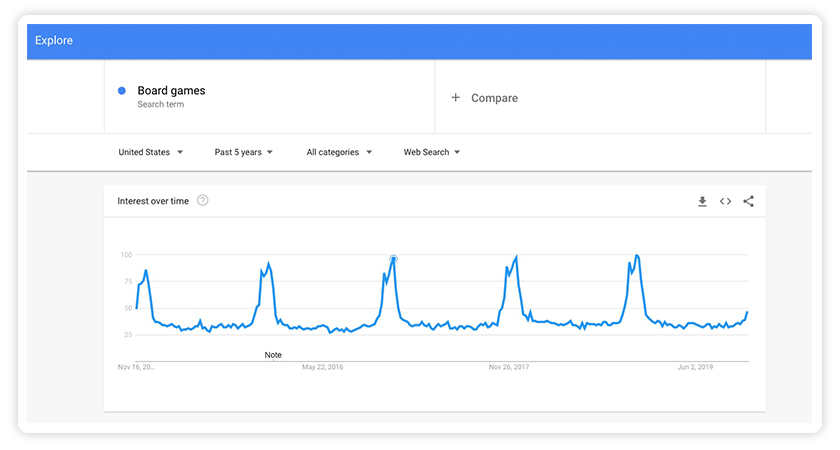
Keywords like these offer more impression opportunities during the holidays versus other times of the year. It makes sense, then, to increase bids for these keywords to get a higher impression share and, in turn, clicks. At the same time, you might discover some product-related keyword phrases don’t show a dramatic increase in search volume or sales during the holiday season. You can redistribute ad spend by bidding less on these keywords during that time.
Even if you use automated bidding, you can still make manual bid adjustments to target more valuable keywords during the holiday shopping season. It’s vitally important, though, that you know when to gain control of your automated bidding strategy. Ultimately, it’s a machine, and your results from the machine will only be as effective as the information given to it.
Most advertisers don’t bother creating campaigns to target holiday-specific keywords every year. So this is a huge missed opportunity to reach a highly targeted audience that is ready to convert on search.
For instance, someone searching for “stocking stuffer ideas for toddlers” is definitely looking for Christmas gifts, and therefore is more likely to purchase the sponsored product suggestions:

It doesn’t require a significant time investment to create dedicated holiday PPC campaigns. Simply duplicate one of your current campaigns, replace the keyword lists, allocate more budget, and then wait for the increased conversions to roll in.

Now let’s look at another long-tail keyword - “christmas gift ideas for friends”. Consumers searching with this type of phrase know that they want to purchase something; they’re just not sure exactly what. Your ads are an opportunity to show them what you have on offer. Even if they don’t purchase the product you’re promoting, they can click through and convert on your website.
Whether you’re running shopping ads or a traditional search ad campaign, it’s important to include relevant information that relates to the very specific audience you’re targeting. For example:
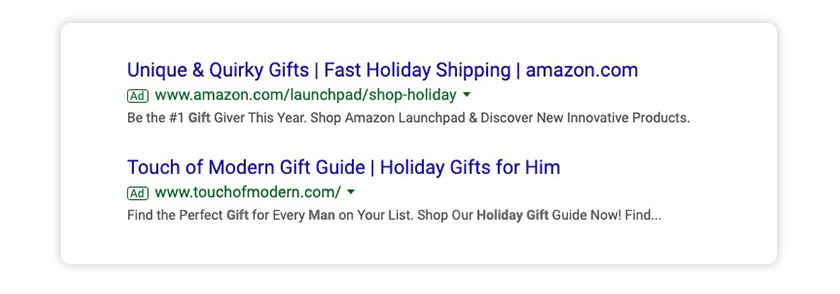
People who look for holiday gift ideas online are often crunched for time. So, one of the above ads includes “Fast Holiday Shipping” in the headline to speak to this need. The second ad’s description says “Find the perfect gift for every man on your list.” This implies their business is a great place to find a gift for husbands, fathers, brothers, etc.
You should definitely base this year’s holiday PPC campaigns on last year’s performance, but don’t let that limit you from trying out new strategies altogether. The winter season is a great time to test out new channels, campaigns, and targeting strategies.
Set aside a certain portion of your PPC budget to try new initiatives. It could be a new targeting strategy or trying out a new feature in Google Ads. If you haven’t already, consider investing in automated bidding strategies. Instead of turning off your manual bidding campaigns, simply create an additional automated one. Then you can test and see which performs better.
Google’s Smart Bidding offers a variety of bidding strategies based on differing business goals. You can also use seasonality adjustments if you expect major changes in your conversion rates based on select events. Smart Bidding automatically considers predictable seasonal factors like Black Friday, Cyber Monday, etc.
Last year Google also introduced Smart Shopping campaigns for eCommerce advertisers. These combine Standard Shopping and display remarketing campaigns, helping advertisers win ad placement in prominent places across networks.
Arguably the biggest opportunity that eCommerce sellers should take advantage of this holiday season is Bing paid search. In November last year, Bing saw the highest retail growth from 5th November pre-Cyber Week. Here were their top categories for click share from 23rd - 27th November:

Bing PPC is less crowded than Google, making it easier to outbid your competition. The Bing audience is also willing to spend more on retail products than those on Google. So, consider investing in Bing this holiday season to get more reach and drive more sales.
Feed optimization is something that you should be working on all year round. But right before the holiday shopping season is an excellent time to start cleaning things up to ensure you give your conversion percentages a boost. This includes optimizing such elements as:
Regardless of whether you’ve already optimized all these things before, there’s always changes you can make that might improve click-through rates. Something as simple as changing the main product image can have a huge impact on performance. You can use Supplemental Feeds to test changes you make to different feed variations.
You should also go through and make sure all your fields are populated as missing data can cause Google to disapprove of products. Then you need to be certain that you’re not sending paid traffic to any “out of stock” product pages. You don’t want this happening during peak holiday shopping weeks.
Targeting audiences during the holiday season is a bit different than the rest of the year because people are primarily not shopping for themselves. In order to better target gift-givers, advertisers need to make changes to their marketing content and ads.
People often know what they want to buy for themselves, but are unsure about what others will like. Your marketing content should make efforts to convince readers that your products are something their loved ones would enjoy. Including social proof from other happy customers is a great way to do this. Solicit user-generated content (UGC) from your previous customers to highlight on your landing pages.
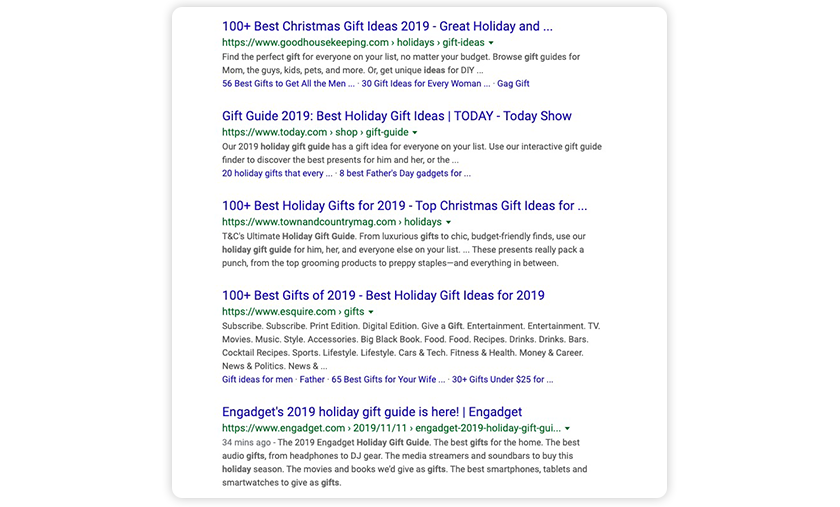
Creating top of the funnel content like gift guides can also help shoppers make decisions about the types of products they want to buy for their friends and family. This is a great way to supplement your paid search efforts with content for organic search engine results.
For your advertising copy, consider the target demographic in this case. People often do their holiday shopping online because they’re too busy to hit the physical stores or they’re looking for deals. Your ad copy should reflect this need. If you want your ads to perform well, promotions are simply a must. Use promotion extensions for search ads to highlight a sale, free shipping, free gift, etc.
Lastly, if your business offers gift cards and free shipping, make sure these options are clear on all your sales and product pages. Particularly in December, when shoppers are feeling rushed, they’re more likely to turn to gift cards rather than buying a product. You can even create special promotions highlighting your gift card offerings (e.g. buy a gift card valued $100 or more and get an additional $10 gift card free).
The type of ads you use can also have a huge impact on performance when targeting gift-givers. Showcase Shopping ads, for example, are a great option to help shoppers understand what kind of products are available related to a broad keyword search. Showcase Shopping ads allow you to group a selection of related products together to introduce audiences to your brand:
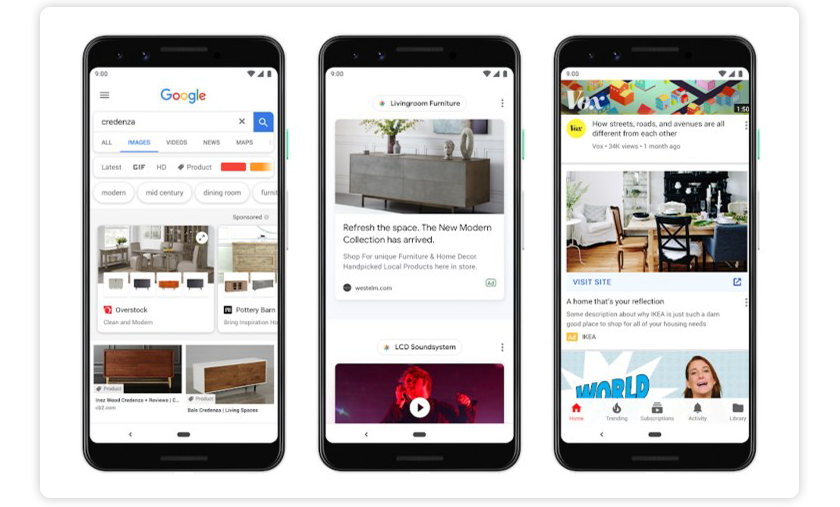
This is a great option for targeting first-time shoppers who want to learn more about a selection of products they’re interested in purchasing as a gift for someone else. This year, advertisers can also include video content as part of their Showcase Shopping ads, offering a new opportunity to stand out from competitors.
Audience targeting is another important area in which to make changes in order to better reach gift-givers with your advertising message. You may want to refocus efforts with your current audiences and/or add new audiences to improve your targeting.
Add new audiences
If you’ve created marketing content for your organic SEO efforts, you can build new audiences based on those who’ve interacted with it. For example, visitors who viewed a wishlist from your eCommerce store or people who viewed a gift guide.
Prepare remarketing lists
Remarketing lists are a great way to reach holiday shoppers later in the season. They may have visited your website in early November, but you can convince them to finally convert right before Christmas with a special offer.
Your remarketing lists can include repeat past purchasers, but what about the people who bought from you last November then never made a purchase again? These are much more likely to be gift-givers. Add them to your remarketing lists to convince them to shop with you again this holiday season.
Consider cross-channel marketing
Remarketing lists are also a great opportunity to drive conversions with cross-channel marketing. To explore the opportunities here, check out your Audience report in Google Analytics. This will show you how your audiences move through the funnel across marketing channels.

Do some experimentation here. You might find that re-targeting shoppers who clicked on your search ad with a relevant Facebook ad drives more conversions. Cross-channel marketing gives advertisers the opportunity to really drive their message home, convincing shoppers to buy.
As mentioned above, most people prefer to do holiday shopping online because they’re busy, it’s convenient, and they’re looking for deals. Shoppers have many options to make purchase decisions online. If you want them to choose your products, you need to make every effort to minimize barriers to purchase.
Offering free shipping is one of the best places to start. 9 out of 10 consumers say free shipping is their biggest incentive to shop online. Another important factor is the option for in-store pickup. Especially in a week or so before Christmas, many people are shopping online with the hopes of picking up a product in-store. These are both benefits that you can highlight on your product pages as well as in your shopping ads with merchant promotions:

There are many other changes that can make the online shopping experience easier and help reassure customers they’re making a good choice. You can guarantee shipping delivery before the holidays, for example. Or highlight your return policy, so they know they can get their money back if someone doesn’t like their gift. Streamlining your checkout process is also essential.
Businesses today have made a lot of efforts to improve mobile user experience, yet mobile cart abandonment is still 86% on average - much higher than on desktop. Lowering cart abandonment on mobile is particularly important during the holiday season, as last year the mobile share of digital commerce reached 40% on Thanksgiving.
In addition to improving mobile user experience on-site and during checkout, I would definitely suggest setting up a series of cart abandonment emails and retargeting ads to help capture these sales.
Online shopping during the holiday season will only continue to grow. Incentives like sales, same-day shipping and in-store pick up have made online the preferred shopping method for many before the holidays. So optimizing your holiday PPC campaigns to capture traffic isn’t just worthwhile, it’s mandatory for eCommerce success today. Prioritizing key months in your PPC strategy will ensure you stay ahead of the competition and maximize the value of holiday shopping to drive more sales every year.
The holidays are upon us! As you’re making your advertising wish list this season, don’t forget to add search and social. Think about it—your customers are already compiling wish lists of their own and now is the time to reach them wherever and whenever they are filling their carts.
These days, it seems there are more ads competing for consumers’ attention than snowflakes on the ground. Therefore, it’s critical that your message reaches the preferred audiences at the right moments. Search and social campaigns are nimble and well-suited to adapt to holiday demand!
Target, segment, and engage your audiences with the right search and social techniques, and make for a very jolly holiday season. If you’re looking for a last-minute holiday or year-end push, download our holiday infographic for strategies to boost performance quickly.
If you’ve been gingerly dipping your toes into OTT (Over The Top) advertising—2020 is your chance to jump in and make a big splash!
The new year will not only ring in a new decade, it will also hold the Tokyo Summer Olympics and U.S. presidential elections—just think of all the eyes tuning in to these momentous events!
The way the we consume entertainment has changed since the days of traditional TV, but the average time spent watching digital video is on the incline. Audiences are out there—and they are on multiple devices.
There are 200 million active CTV (Connected TV) viewers and nearly 98 million households that own a CTV device. OTT and internet-enabled devices like Roku, Firestick, and Xbox are great for reaching audiences on multiple devices. Based on those numbers alone, it’s clear that Advanced TV will be a big winner in 2020.
The Olympics have embraced changing TV viewing habits with their slogan, “Discover Tomorrow,” and a Sony/Panasonic partnership to broadcast games in 8K resolution in 2020. With 26 million viewers (that’s one-fourth of all TV viewers), NBC is on pace for $1.2 billion in ad spending during the games and the weeks leading up to it. General Manager of the IOC’s Global Olympic Channel, Mark Parkman, stated “as the Olympic Channel continues to grow and evolve, we are dedicated to making our content available wherever our audiences are watching, in an effort to create more personalized experiences for our viewers.”
On November 12th, 2019, Disney launched its much-anticipated platform Disney+. Disney is new to the streaming scene but is set to compete with the big players like Netflix and Hulu in 2020. Disney+ achieved 3.2M app downloads within the first 24 hours post-launch.
There are no shortages of audiences to engage with via OTT. How do you make sure you’re not wasting your ads on the wrong ones? Good news—OTT is addressable, meaning it can serve different ads to different people consuming the same content.
You can use sophisticated targeting capabilities to put the right messages in front of the right people, allowing for more personal connections and meaningful experiences for consumers.
Political campaigns have also caught on to the trend, with OTT ads increasing 200% between 2016 and 2018. Digital video went from 1% of advertising budget to 30% of the budget in just two years. The 2020 election will also see a bigger piece of the OTT pie with 2018 budgets coming in at $740 million and 2020 budgets projected at $1.6 billion. That’s the largest percentage of overall budgets devoted to digital video to date!
2020 may seem like it’s still in the distant future, but these big events will be here before we know it! Don’t wait when it comes to OTT—2020 is your year to win!
Learn more about Connected TV Advertising with Centro.
“I rented a lake house in Austin with my dog Fenway.”
“I went to Africa and hiked to see gorillas in Rwanda.”
“My husband and I spent three full weeks covering the entire West coast!”
“We took a two-week trip to Italy for a wedding and absolutely loved it.”
These are just a few of the experiences Centro employees have had through Centro’s sabbatical program. What is a sabbatical, you ask? It’s three-weeks of paid time off that any Centron can take advantage of during their fourth year of employment.
In competitive industries such as tech and finance, professionals often work 60+ hours per week—in addition to being available 24/7 by smartphone. The employees of today are waking up and checking their work accounts for emails, calls, and texts before their feet even hit the floor.
Today’s around-the-clock work week has created new concerns for employers, including high rates of employee burnout and turnover.
A vacation day here and there is great, but we all know how fast a long weekend can fly by. Centro’s sabbatical program was created when our leadership team asked themselves what might change if employees could take longer breaks from work. How would it affect their mental health and productivity? How would their engagement change when they returned to the office?
Formal research has found that employees are more productive and creative after returning from longer breaks, and that these breaks offer companies valuable insights into succession planning and organizational chart stability. Feedback from Centrons who have taken advantage of the sabbatical program has confirmed these research findings:
“It is rare during anyone’s professional career they can take three weeks off...It was a special time to see a different part of the world and, most importantly, spend time together.”
“I was able to reflect and establish goals for the next part of my life. It was incredibly restorative.”
“The sabbatical was an amazing lesson of how to delegate responsibility and offered a completely new perspective on my return to work.”
We’ve seen first-hand that our business benefits from the program as well. To quote Emilie Clark, whose team member recently returned from sabbatical, “I now have someone with the commitment and engagement of a new hire with all of the competency and knowledge of a tenured member of the team.”
Curious about Centro’s sabbatical and total compensation offerings? Learn more about our perks and benefits here.
Businesses today must stretch their budgets to reach more and more profitable marketing channels, both online and off. The number of options only continues to grow. Online retailers and eCommerce sellers, in particular, have an important choice to make between Google Shopping, Amazon, and Facebook to promote their products.
Platforms are also constantly evolving, offering new targeting functionalities and benefits to entice advertisers. Facebook remains a powerful innovator, making it the most valuable option for marketers who want to invest in social media advertising.
Here are some reasons why Facebook marketing remains a good investment today and will continue to be an important advertising outlet in the long-term:
Platforms like Google and Amazon have impressive targeting options, but none can compare to Facebook’s capabilities. Facebook has been collecting detailed demographic and behavioral data on its users for more than a decade. Below are just some of the many targeting options advertisers can use to build audiences on the platform:
Facebook advertising allows you to create customized audience groups based on any combination of these targeting factors:
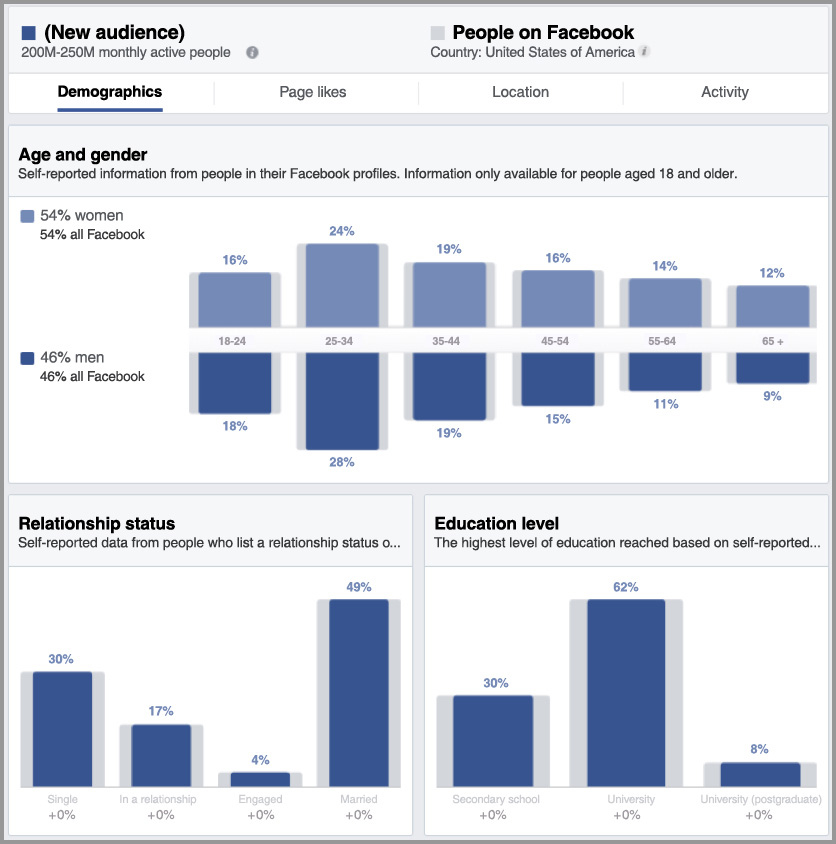
Other advertising outlets offer some of these targeting options, but not at the same volume or granularity as Facebook. When you use Facebook ad targeting to its full extent, you deliver more relevant marketing messages to your audience. This drives more clicks and conversions overall.
According to a recent survey from Clinch, consumers agree that Facebook is the best platform for product discovery and purchasing. As long as Facebook continues to offer the best targeting options in the ad industry, this is unlikely to change.
There are lots of ways to spread your marketing budget in 2020. Marketing managers are stuck with the difficult task of deciding how much to invest in different advertising channels. In general, social media advertising can help you drive improved performance with a lower budget investment. Facebook is the leader in helping advertisers target very specific audiences and increase revenue from their marketing dollars.
According to Hootsuite, marketers spend 20 times as much on TV ads as they do on Facebook videos. Despite spending 20 times more, though, the reach for TV campaigns is less than half of a social campaign:
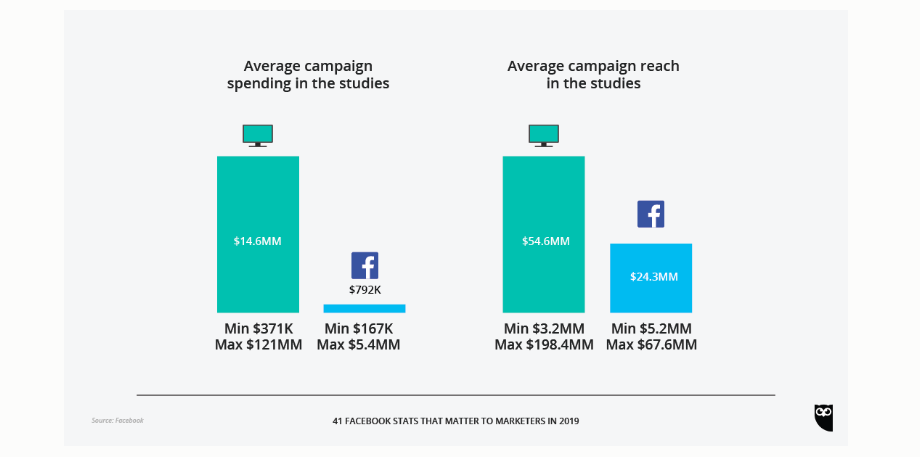
In another survey asking advertisers which platform offers the highest digital ad ROI, 48% choose Google search. Facebook came in second at 30%, significantly leading all other social platforms in performance.
If marketers plan to invest in social media advertising at all, Facebook must be the place to start. In today’s competitive landscape, all managers must be carefully investing their budgets in strategies that drive the most revenue.
Facebook offers a variety of ad types: image, video, slideshow, carousel, instant experience, collections, and more. You can optimize your campaigns using any of these options to drive sales of your products. Carousel ads, for instance, allow you to include an array of images that illustrate the value of your product.
Facebook ads also offer some unique features designed to help eCommerce sellers drive sales on the platform. For example, multi-product ads offers advertisers the chance to display numerous product images in a single ad:

You can set it up so when someone clicks on individual products in an ad, it takes them to a unique landing page. With visual Facebook ads, you can further promote discounts to encourage your audience to act now:

Facebook Shops is a valuable (and often underutilized) feature that helps you create a virtual storefront on the platform. No other social media outlet has a similar option. A Facebook Shop is a page with a selection of products connected to your business page. It’s the most appealing to merchants, retail, and eCommerce advertisers who want to reach more people with their products on Facebook.
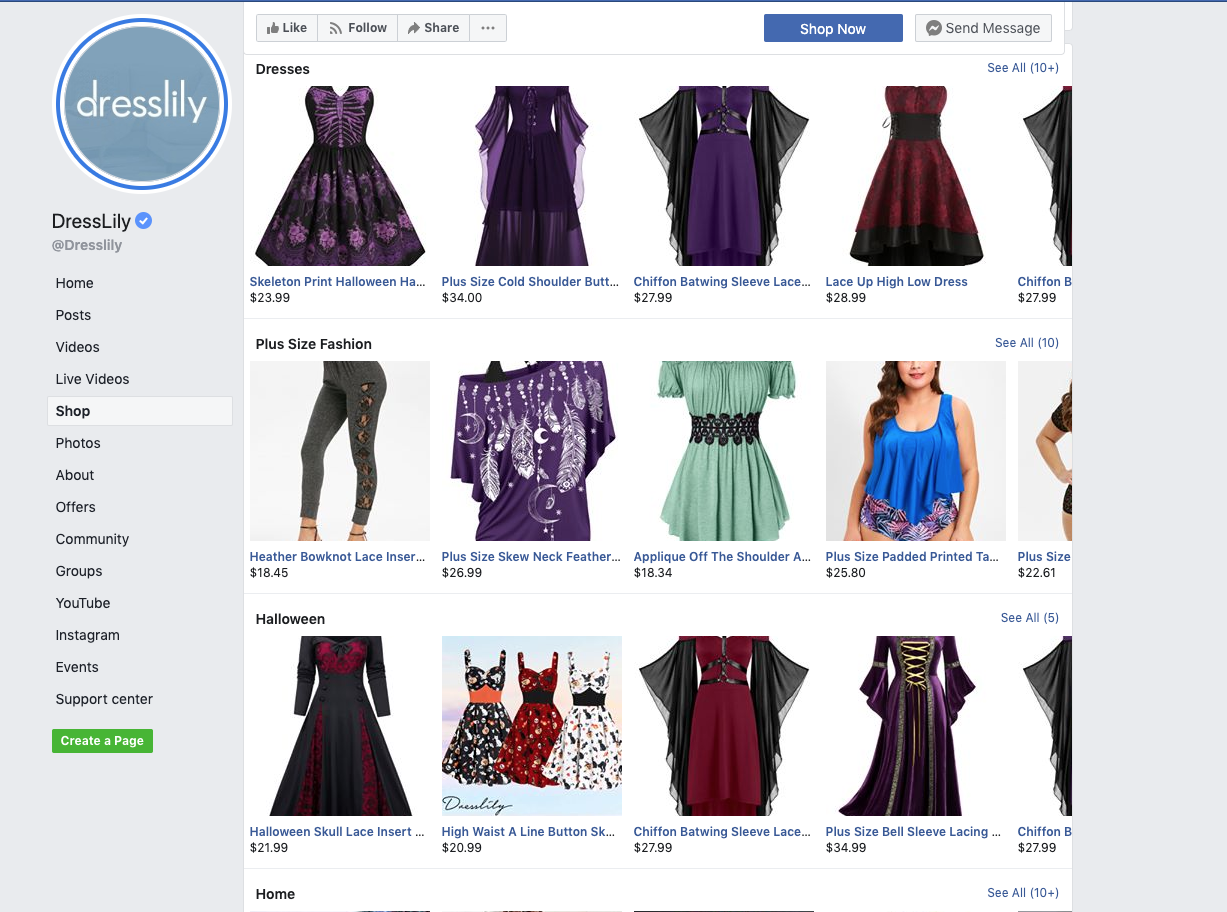
A Facebook Shop can help you:
Instead of displaying products on static pages on your eCommerce site, Facebook Shops encourages people to engage in social conversations surrounding your products. This offers social proof that can influence more people to buy.
It’s possible to create Story Ads for both Facebook and Instagram. This is a valuable strategy to capture the attention of your audience on the platform—especially considering that more than 300 million people use Facebook Stories and Messenger Stories every day.
Facebook Story Ads help advertisers meet all sorts of goals, including building brand awareness, video views, app installs, conversions, traffic, and generating leads. For eCommerce sellers, they’re a great opportunity to showcase products in real-world applications:
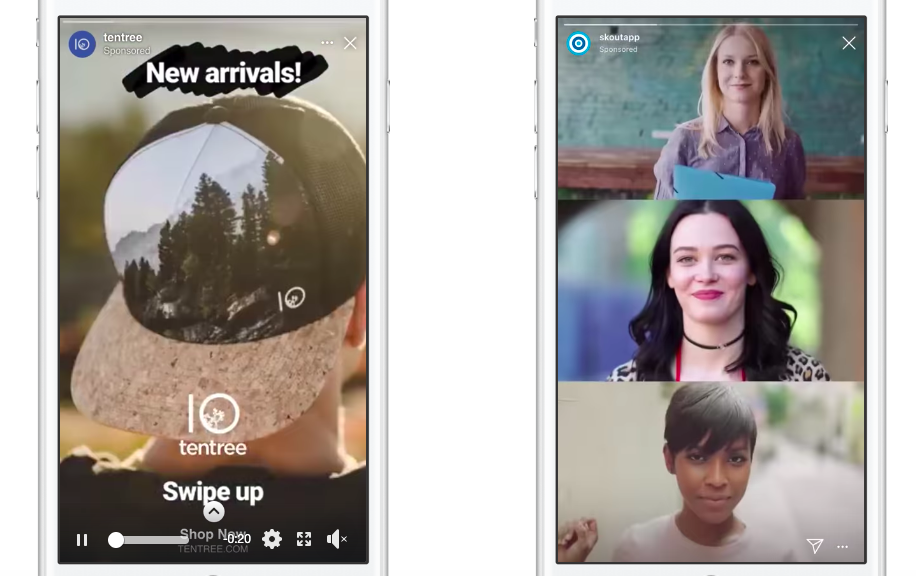
According to an Ipsos survey, 62% of people say they’re more interested in a brand or product after seeing it in a story. And more than half of people say they’re making more online purchases as a result of seeing stories.
Since Story Ads are included alongside normal stories from people’s friends, it’s much easier to capture audience attention with your ads. Facebook might not be the only advertising platform offering Story Ads (Snapchat also has this option), but it definitely has the largest audience to work with.
Your advertising strategy shouldn’t exist in isolation from the rest of your marketing initiatives. Getting people to click on your ad is just the first step in the customer journey. You need to effectively nurture them to make a purchase as well.
Facebook Messenger offers a huge opportunity for advertisers to nurture their leads. Rather than sending ad clicks to a landing page on your website, you can direct them to a conversation with your business in Messenger.
So, what’s the main benefit of this?
A look at Facebook’s 2019 Holiday Shopping Guide tells us that 65% of holiday shoppers report being more likely to shop with businesses they can instantly message.
Once you open a dialogue with your audience in Messenger, you can use the platform to deliver more relevant marketing content. You can also use it for lead generation by capturing their contact information. This is particularly valuable for businesses promoting expensive products or those with a long sales cycle.
Facebook further allows you to create ads to target audiences within Messenger. No other advertising platform offers this kind of interactive targeting and nurturing scenario. Having the ability to converse with your audience using customer service representatives or even automated chatbots can do wonders for turning ad clicks into sales for your business.
Facebook is constantly coming up with new ads, targeting features, and optimization functionalities to improve how people can market their products on the platform. For example, in September 2019, they updated their product catalogs to improve the speed of data feed uploads. This helps eCommerce advertisers keep their data feeds current and accurate, so their ads match the information on their landing pages.
While small changes like this can go a long way to improving conversions and revenue, it’s Facebook’s ability to revolutionize the online shopping experience that really makes it one of the most valuable advertising platforms. At a recent marketing conference, Facebook hinted that updates to their AR platform will have applications for retail and shopping environments. In the future, AR shopping will allow shoppers to virtually try on products using a phone camera.
This offers a unique shopping experience where people can match makeup colors, test out a piece of furniture, try on sunglasses, and more:

Whether you’re just getting started with Facebook marketing or you’re looking to reinvest, these important strategies are trends for success in 2020 and beyond:
One of the biggest benefits of Facebook marketing is creating and targeting different audience groups at a granular level. A lot of advertisers don’t bother digging into these specific groups, though, simply because they’re smaller. Targeting smaller groups of people drives up your cost per 1,000 impressions (CPM), but it also gives you an opportunity to create a marketing message that’s relevant to each.
Smart advertisers invest in creating numerous ads as well as making micro-changes to each to improve targeting. Look at this multi-product ad for nursing dresses, for example:
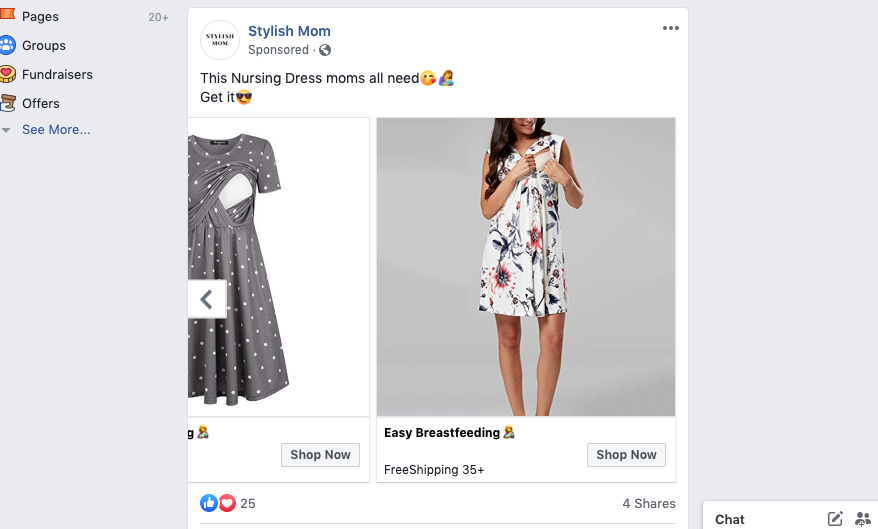
It’s targeting women of childbearing age, but the brand could be more specific with their ads by also targeting life events (e.g. maternity dresses for pregnancy versus nursing dresses for after giving birth).
Facebook can also help you discover new audiences to target based on your current audience data. Lookalike Audiences is a feature you can use to reach out to new people who may be interested in your business because they have similar traits to your current audience.
Creating video marketing content for Facebook is often very involved and costly, but it also delivers the best results. Video remains the most popular content type on a platform known for passive engagement.
There are several different types of video content that advertisers can invest in, from video posts to Stories and Facebook Live. People spend three times as much time watching a live video than a pre-recorded one. Live videos offer some humanity for brands, making them look more authentic.
Brands can also upload 360 videos to Facebook. These are videos that record all 360 degrees of a scene so viewers can watch different angles. Brands like AT&T, Samsung, and Nestle have boosted posts using this video format to successfully capture audience attention, improve engagement, and drive conversions.
Prioritizing mobile user experience in marketing is nothing new, yet many marketers take it for granted today. Having a responsive website design is just the first step in optimizing for mobile. You also need to have ongoing assessments of user experience for your different marketing initiatives, especially with Facebook. Consider:
Mobile-first Facebook marketers need to know how their ads and marketing content look on mobile devices. When users click on ads, how do the landing pages appear?
Marketers must also consider how audiences might perceive their brand if they only interact with their marketing content on mobile. For example, mobile ads take up much more screen space than on desktop. Could your brand possibly come off as intrusive or annoying in this format?
Businesses should further test out the ease of use on the path to conversion on mobile versus desktop devices. Eliminate barriers to ensure users can easily shop and convert on mobile. Thanks to AR videos, Stories, Facebook Shops, and multi-product ads, a lot of the shopping experience can happen on Facebook itself, as opposed to your website. So mobile-first optimization means considering both your website and the advertising platform itself.
Facebook advertising isn’t just about broadening your brand reach on social media, it’s also a valuable platform on which to target your current leads, convincing them to convert. If you install Facebook’s tracking pixel on your website, you can easily launch retargeting campaigns. This allows you to show ads to people who have engaged with your brand in the past. Previous website visitors that you retarget with display ads are 70% more likely to convert.
Facebook allows you to create custom audiences for targeting based on different behaviors, such as visiting a certain web page or adding items to a cart without checking out. You can also upload data you’ve collected from your audiences, such as their names, email addresses or phone numbers. Facebook will automatically connect this information to their associated Facebook profile.
Businesses can use retargeting ads for a number of objectives, from awareness to consideration and conversion. eCommerce sellers get the most value by targeting conversions, online catalog sales, or in-store visits.
It’s important to remember that Facebook is a platform for passive engagement, as opposed to active searching for products and services. Marketers can target their audiences with the most relevant message, but it can easily become part of the background of scrolling and content consumption.
If marketers want to drive their audience to take action, they need to offer a reason. For eCommerce sellers, this can be promoting an offer or sale to drive conversions. For businesses looking to generate leads, this can be promoting a sweepstake to capture contact information.
Facebook’s AR technology also offers new options to encourage audiences to engage with your products:
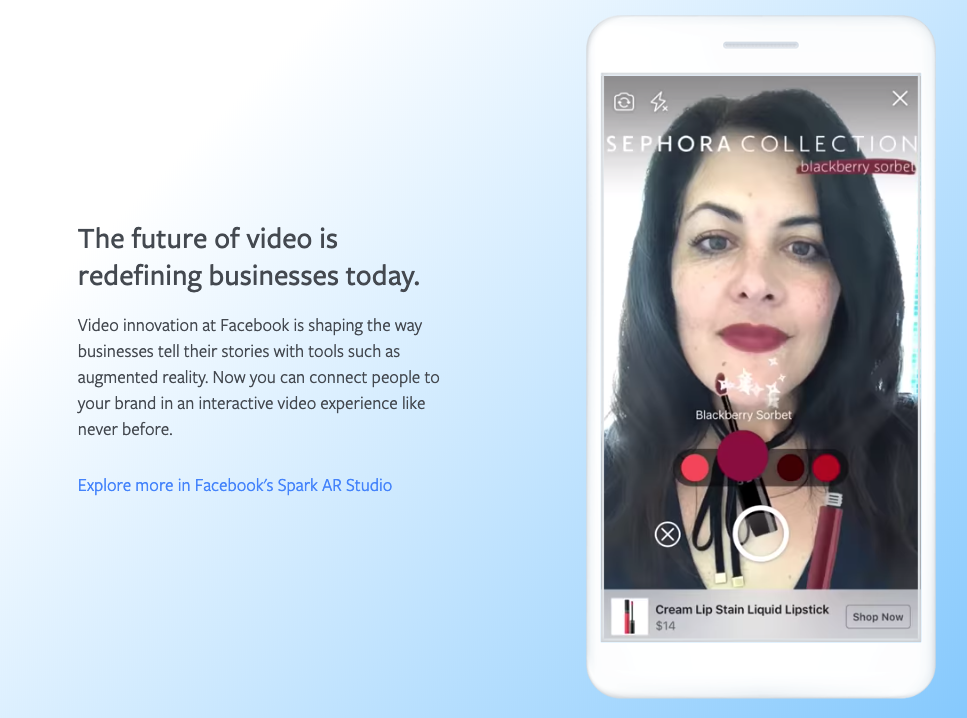
Data giant Facebook is constantly looking for new ways to leverage user information to create a better advertising experience. With ad revenue as high as $16.6 billion per quarter, the platform is invested in helping advertisers make it easy to reach their target audience and drive conversions.
So the question is not if Facebook advertising is a good investment, but instead how businesses can best allocate their budget and ad strategy to maximize the benefits for their marketing initiatives.